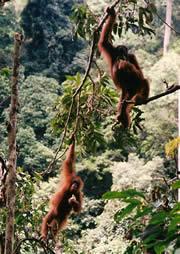 Orangutans stand upright — with help from their hands — to move along narrow branches.S.K.S. Thorpe
Orangutans stand upright — with help from their hands — to move along narrow branches.S.K.S. ThorpeA study of orangutans walking through the tree-tops suggests that humans' ancestors may also have first stood upright in the trees, say researchers.
The apes stand on two legs when moving along narrow branches, using their hands to steady them, say Robin Crompton at the University of Liverpool, UK, and his colleagues. They believe that a similar behaviour is the most plausible precursor of true bipedal walking.
The question of how humans came to walk upright has perplexed anthropologists. It is difficult to work out which came first: living on the ground, or walking on two legs.
The problem is finding an evolutionary advantage for standing upright. It's been proposed, for example, that standing exposes the body to less sunburn on the savannah, but our ape ancestors might have spent most of their time in shady forest.
The new research shows that a tree-dweller can benefit from standing up. "This research makes the strongest case yet that bipedalism could have evolved arboreally," comments Dennis Bramble, who studies animal locomotion at the University of Utah in Salt Lake City.
A free hand
Crompton and his colleagues obtained nearly 3,000 observations of wild orangutans moving through the forests of Sumatra, and recorded the diameter of the branches the apes were crossing. Orangutans spend more of their time in the trees than any other great ape.
It turned out that hand-assisted bipedal movements were most common when the animals were walking on slender, bendy branches. The results are reported in Science1.
This shows the benefit of assisted bipedalism, says Crompton. "There is a lot of pressure on fruit-eaters to go to the periphery of trees where branches are smallest, because that's where the fruits actually are," he says. "If you can have a hand free when you get there, all the better."
Another advantage is being able to reach out with a free hand to the branches of an adjacent tree, and cross to it without the effort of descending.
"This is a good argument for why upright posture would be selected for in trees," comments anthropologist Daniel Lieberman of Harvard University in Cambridge, Massachusetts.
On all fours
Most apes have been seen to walk on their hind legs while using a hand or two to balance themselves, although they seem to move this way only about 5% of the time.
The widespread nature of the trait makes it likely that humans' ancestor could also do this, supporting the idea that assisted bipedalism might have evolved into true bipedalism.
But this causes another problem. Humans' closest relatives, chimpanzees and gorillas, walk on all fours, and fossils provide strong evidence that our ancestors did the same (see 'These fists were made for walking').
"Unless knuckle-walking evolved independently in both the chimpanzee and gorilla lineages, the evolution of bipedalism from an orang-like form of arboreal assisted bipedalism seems unlikely," says Lieberman.
ADVERTISEMENT
"I've always been attracted to the arboreal hypothesis, but I just can't see how to reconcile the two theories," adds Bramble. "If there is a middle ground, I do not see it."
Further studies of chimpanzees might help to solve the issue. If they were seen to use arboreal assisted bipedalism in the same way as orangutans, it would give the theory a big boost.
Visit our orangutanspointwayt.html">newsblog to read and post comments about this story.
